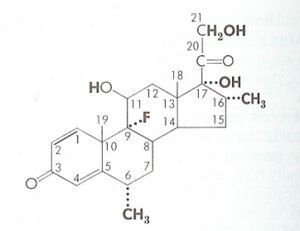Corticosteroids
Cortisol metabolism has been studied extensively. It is generally assumed that other related compounds have similar metabolism. Cortisol has a plasma half-life of around 1.5 hours. The metabolism and half-life of corticosteroids is greatly slowed down with the presence of a 1,2 double bond or a fluorine atom. Laboratories measure urinary cortisol and metabolites with the reduced ring A as "17-hydroxycorticosteroids." These compounds and those where the ketone at carbon 20 has been reduced are included in the group "17-ketogenic steroids." Urinary metabolites that have lost their side chain are included in the "17-ketosteroids." It is estimated that the liver metabolises at least 70% of secreted cortisol.

The first corticosteroid used for its anti-inflammatory effect was Cortisone. The structure was modified leading to increases in the ratio of anti-inflammatory to sodium-retaining potency. In a number of currently available compounds, the electrolyte effects are now of no serious consequence, even at the highest doses used. In all compounds the effects on inflammation and metabolism of carbohydrates and protein have paralleled one another. The effects on inflammation and metabolism are likely mediated by the same type of receptor.
Changes in the molecular structure can cause changes in biological potency. This can be due to alterations in absorption, protein binding, rate of metabolic transformation, rate of excretion, ability to traverse membranes, and intrinsic effectiveness of the molecule at its site of action. Modifications of the pregnane nucleus has been used for therapeutic value.
Ring A. The 4,5 double bond and the 3-keton are both necessary for typical adrenocorticosteroid activity. Prednisone and prednisolone introduce a 1,2 double bond. This enhances the carbohydrate-regulating potency resulting in an enhanced ratio with respect to its sodium-retaining potency. Prednisolone is also metabolised more slowly than cortisol.
Ring B. 6α substitution has unpredictable effects. For cortisol, 6α methylation increases its anti-inflammatory, nitrogen-wasting, and sodium-retaining effects. While 6α-methylprednisolone has a slightly greater anti-inflammatory potency and less electrolyte-regulating potency compared to prednisolone. Fluorination in the 9α position enhances all biological activities of the corticosteroids, apparently due to electron-withdrawing effect on the 11-beta-hydroxy group.
Ring C. Oxygen function at C 11 is indispensable for its significant anti-inflammatory and carbohydrate-regulating potency (cortisol vs 11-dexoxycortisol). However this is not necessary for its high sodium-retaining potency (desoxycorticosterone)
Ring D. 16-Methylation or hydroxylation eliminates the sodium-retaining effect but only slightly modifies potency on metabolism and inflammation
All currently used anti-inflammatory steroids are 17α-hydroxy compounds. 17-desoxy compounds (cortisol vs corticosterone) may have some carbohydrate-regulating and anti-inflammatory effects but full action requires the 17α-hydroxy substituent. All natural corticosteroids and most of the active synthetic analogues have a 21-hydroxy group. This is required for significant sodium-retaining activity, but some glycogenic and anti-inflammatory effects may occur without it.
Dose Equivalency
| Glucocorticoid | Approximate Equivalent Dose (mg) |
|---|---|
| Cortisol | 20 |
| Cortisone | 25 |
| Hydrocortisone | 20 |
| Prednisone | 5 |
| Prednisolone | 5 |
| Methylprednisolone | 4 |
| Triamcinolone | 4 |
| Betamethasone | 0.6-0.75 |
| Dexamethasone | 0.75 |
Choice for Injection
There is limited evidence to help guide the choice of a specific glucocorticoid for injection. Depot formulations stay at the injection site displaying mostly local effects, but some system effect can happen. The choice is largely based on availability, cost, and versatility. At the time of writing, the funded corticosteroids for depot injections are dexamethasone, methylprednisolone, and triamcinolone. Betamethasone is also available but is only partially funded. Dexamethasone is available on medical practitioner supply order, but only 5 vials at a time. Many practitioners tend to use particulate corticosteroids (like triamcinolone) for joint and soft tissue injections, and non-particulate corticosteroids (like dexamethasone) injections where there is a rare risk of serious vascular injury like spinal injections.
References
- ↑ Liddle 1961, Clinical Pharmacology and Therapeutics

